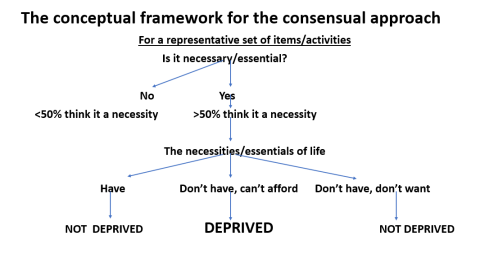The implementation of the consensual method of multi-dimensional poverty measurement is simple and straight forward. It uses a representative sample survey; this can be attached as a module to existing national surveys, if desired. The survey has two main aims. First, to identify a range of socially-perceived necessities - items, activities and services that no-one should have to do without. And second to identify those who have an 'enforced lack' of the item or activity - that is they go without these items because they cannot afford them or do not have access to them. Only those who have an enforced lack of a socially perceived necessity are seen as deprived. The survey therefore has three key questions:
- Is an item a necessity?
- Do you have it?
- If not, why not?
Identifying socially perceived necessities
These items and activities cover (as appropriate for the society in which the survey is being conducted):
- Social and family life
- Diet
- Clothing
- Heating
- Medical access
- Accommodation & housing standards
- Educational access
- Household items
- Financial items
- Items for children
- Transport
- Basic services such as access to water or electricity
The items should be specific and allow (as appropriate) for thresholds, frequency, reliability and quality. A range of items and activities have now been tested in high-, middle- and low-income countries and form a core set of questions that can be included (see: the PSE UK questionnaires, the EU material index and the EU child deprivation index and examples from under the country covered in the World section above). The items, activities and services should reflect the society to which they are applied, preferably identified through a range of focus groups that explore what is important for living today. These focus groups should reflect a range of groups in society by age, gender, employment status, household income, location etc. For identifying child necessities it is useful to also have focus groups with children.
The following papers (download the pdfs from the links) provide an overview of the use of focus groups in establishing survey questions for the consensual method.:Multidimensional child poverty and deprivation in Uganda, Volume 2: Views of the public, report’, GoU and UNICEF, March 2019, ‘Multidimensional child poverty and deprivation in Uganda, Volume 2: Views of the public, report’, GoU and UNICEF, March 2019 and 'Public perceptions of Child and Adult Poverty in Tonga', USP, 2019, for examples).
Identifying those with an 'enforced' lack
Survey respondents are asked whether they have each item, activity and service - or not. The survey allows for people to choose not to have an item, or do an activity - this is to allow for personal preference. For items which they do not have, they are asked whether this is because they do not want the item or because they cannot afford it. For activities they cannot do, as well as being asked whether they do not want to participate and whether they don't participate because they cannot afford it, they may also be given the choice of not being able to do that activity for 'some other reason'. For services there can also be a choice of the service not being available. The diagram below represents the conceptual framework for the identification of deprivation using the consensual method for items and then for activities.
Producing a deprivation index
Having identified the items and activities seen as necessities and those who lack the item, it is necessary to test each item/activity to ensure that it is a valid and reliable measure of overall deprivation. The steps to doing this can be found in 'Producing a poverty line in eight easy steps' by David Gordon, PSE:UK, 2017.
The Bristol University Poverty Research Methods course in 2019 provides a useful overview of ways of measuring poverty including details of how to use the consensual method. Presentations can be downloaded here.
Producing an overall poverty measure
The consensual approach identifies a poverty line that maximises the diferences between the poor and the non-poor. This is theoretically based on Townsend's concept of relatative deprivation. This identifies those in poverty as:
‘Their resources are so seriously below those commanded by the average individual or family that they are, in effect, excluded from ordinary living patterns, customs and activities’, Poverty in the UK,Townsend 1979
See: 'Producing a poverty line in eight easy steps' by David Gordon, PSE:UK, 2017, for details.
Author: Joanna Mack




 PSE:UK is a major collaboration between the University of Bristol, Heriot-Watt University, The Open University, Queen's University Belfast, University of Glasgow and the University of York working with the National Centre for Social Research and the Northern Ireland Statistics and Research Agency. ESRC Grant RES-060-25-0052.
PSE:UK is a major collaboration between the University of Bristol, Heriot-Watt University, The Open University, Queen's University Belfast, University of Glasgow and the University of York working with the National Centre for Social Research and the Northern Ireland Statistics and Research Agency. ESRC Grant RES-060-25-0052.






